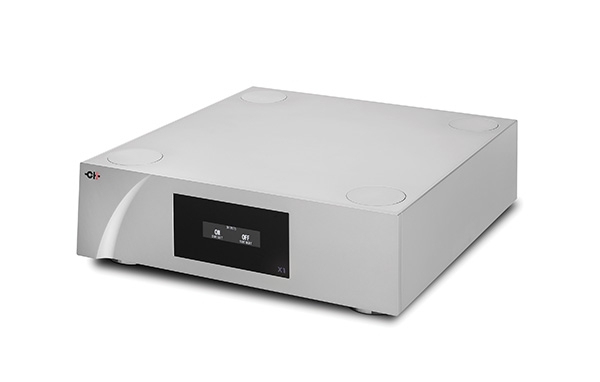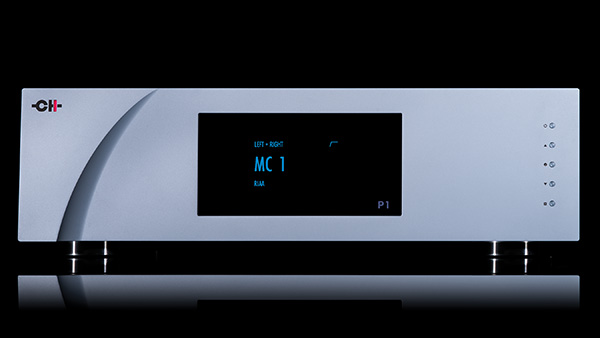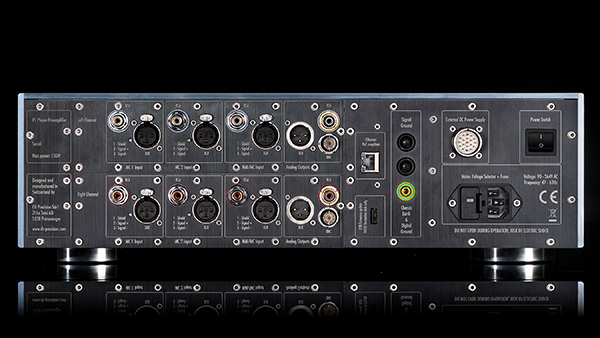| Columns Retired Columns & Blogs |
... JVS have a "nice hi-fi while driving a cheap car"?

The design was so energy efficient that a single degree of temperature change provided enough power for two days of operation; it would take an incredible 60 million Atmos clocks to equal the power demands of a single 15W light bulb. 95 years later, the Atmos Clock is still being manufactured in Switzerland by Jaeger-LeCoultre, but like most high-precision, Swiss-made instruments, it isn't cheap. Prices start around $7500.
Ultrahigh precision combined with wallet-busting price tags has become kind of a hallmark of Swiss design. In this respect, the products from Swiss hi-fi manufacturer CH Precision (footnote 1) aren't exceptions. The name is clever; CH is the not-so-obvious international two-letter code for Switzerland; it stands for Confœderatio Helvetica, the original Latin name for the Swiss Confederation. It is also the initials of company founders Florian Cossy and Thierry Heeb, both of whom cut their audio-design teeth at another great Swiss hi-fi manufacturer, Goldmund.
I have long admired minimalism as a design concept for electronics. My treasured John Curl Vendetta SCP-2B phono preamp uses just a handful of parts on two drink-coaster–sized circuit boards. While it maintains a somewhat minimalist design aesthetic, the P1 phono preamplifier ($31,000) is set to challenge that thinking with a chassis truly brimming with parts. To be fair, a lot of that part count is due to the wide range of features the P1 provides; most of those parts aren't in the signal path at a given moment.
I knew this was going to be a different kind of phono preamp review when CH Precision representative Kevin Wolff asked me what kind of Wi-Fi network I had in my home. I pointed out that I was reviewing the P1 phono preamp and its optional X1 power supply, not some as-yet-unheard streaming device. Perhaps the Swiss have decided that digital sources really are better; maybe the P1 figures out what's on your turntable then streams a digital facsimile from an online source.
Kevin, though, assured me that the P1's signal path is 100% analog; the reason he was concerned about my Wi-Fi is that many of its features are accessed and controlled using an app running on a tablet, so you need a network hookup to relay those commands to the P1. My portable devices are Apple-centric, and the CH Precision app is Android-only, so Kevin agreed to provide a tablet and a compatible wireless router. Operation via tablet is convenient, but I'm thinking that for $31,000, it's reasonable to expect an iPad app. Having said that, while the control app was neat, most of the time I used the front panel buttons and menu-driven display screen to make adjustments. All adjustments can be made from the front panel, but if you want to listen while making changes on the fly—to loading, gain, or EQ curve—the Android app is the way to go.

The P1 is a single-chassis stereo phono preamp that comes loaded with features, but you can configure it in various ways. The first is to add an external linear power supply, the X1 ($17,000), which supplements the power supply inside the P1, adding a dedicated transformer and an extra stage of regulation in a chassis that's nearly identical to that of the P1. CH Precision claims that adding an X1 improves the already superbly quiet P1's signal-to-noise ratio by a further 3–5dB, depending on the input. To minimize the space required by the additional chassis, the P1 and X1 can safely be stacked with no loss in performance. An elaborate vibration-isolating footer system built into each component allows perfect stacking with no risk of damage or interference between the two components.
The next step on the upgrade path is to have your existing P1 converted to mono operation, moving one channel of its circuitry to a second chassis for true dual-mono operation, both P1s powered by a single X1 ($72,000, total). Finally, you can add a second X1 for a four-chassis solution ($89,000).
Even in its simplest form, the P1 is an exceptionally versatile way to amplify your phono cartridges. Its three selectable inputs can be optimized to work with just about any cartridge on the market. All three inputs allow you to choose between RCA and XLR connections. Outputs let you choose BNC, RCA, or XLR. Each of the three inputs can be connected to different arms and cartridges simultaneously, with individually optimized settings and adjustments for each.
I received a single stereo P1 and a single X1, allowing me to experience the benefits of the external power supply without expanding the system all the way up to the rackspace-busting three- and four-chassis setups. This pairing is the same one that Michael Fremer reviewed six years ago (also see his followup here); CH Precision clearly makes products with a long shelf life. The company has structured pricing so that there is no penalty for upgrading in stages rather than going with a multichassis configuration from the start.

In addition to the power supply and dual-mono configurations, there is another option for those of us with an extensive collection of vintage LPs. Optional mono EQ boards ($1850 for a pair) can be added to any P1 configuration, allowing you to select among four playback equalization curves in addition to the standard RIAA curve used for all modern pressings.
There is disagreement among experts as to exactly when RIAA became the de facto standard for all LP pressings. Most insist that everyone was using RIAA when stereo records were introduced in 1958; others are adamant that European labels such as DG, Decca, and EMI continued to use proprietary EQ curves into the 1970s. That debate rages on. The optional EQ board will let you decide for yourself which EQ sounds best by selecting among EMI, Columbia, Decca, and Teldec curves in addition to RIAA.
The three inputs are not all the same. Input three leads to a traditional voltage-mode phono amplifier, which, like the other inputs, uses a clever, automated setup wizard with its own test record to determine the optimum gain and loading settings for your cartridge. Cartridge loading has always been a bit of a black art, with most people choosing by ear from a range of settings suggested by the cartridge manufacturer. The P1 displays frequency response graphs and accuracy scores for a range of loading options on its front panel display, which you can scroll through and choose from while listening.

Inputs One and Two use a current-mode amplifier to amplify low-voltage signals emerging from low-impedance moving coil cartridges. "Current-mode" or transimpedance phono preamplification is not a new idea—I have fond memories of the trans-impedance phono input on Ed Meitner's PA-6i preamp nearly 40 years ago—but the idea has recently gained traction. In addition to CH Precision, companies including Channel D, Lounge Audio, Sutherland, and van den Hul use this approach.
To work optimally, a current-mode amplifier needs a very low-impedance source; moving coil cartridges with internal resistance below 10–12 ohms are the best candidates. For higher-output, higher-resistance MC cartridges with more windings on the coil, you'll probably get better results using the voltage amplifier on input three.
When a moving coil phono cartridge has a very low internal impedance, its output voltage will be very low. But if it is placed in a circuit that itself has very low impedance, the current from the coil moving through that fixed magnetic field will be relatively high. And because, in transistors, the signal-to-noise ratio for current is intrinsically lower than it is for voltage, the amplified signal is much lower in noise. The result is phono output that is spookily quiet.
Because a current-mode cartridge amplifier loads the cartridge with a near short circuit, the familiar concept of cartridge loading no longer applies. You can still use the P1's automated setup wizard and test record, but with the two current-mode inputs, its only role is to set "gain." (footnote 2)
Footnote 2: The quotation marks are because, strictly speaking, a transimpedance amplifier doesn't have gain, which is typically defined as the ratio of output voltage to input voltage, or in any case, that's not the quantity of interest. A transimpedance phono stage converts current into voltage, so "gain" is used loosely.—Jim Austin

... JVS have a "nice hi-fi while driving a cheap car"?

Transimpedance Phono Preamp was...: Goldmund! Remember the fabulous Mimesis Phono 2? It was just out of production, when I joined Goldmund in 1995 and not much later had both the C and the H in my team. Still on all accounts a killer Phono Preamp.